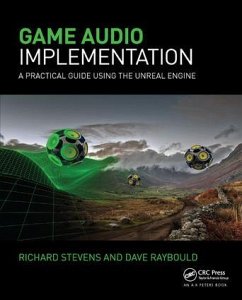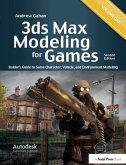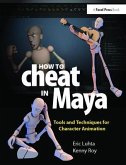- Gebundenes Buch
- Merkliste
- Auf die Merkliste
- Bewerten Bewerten
- Teilen
- Produkt teilen
- Produkterinnerung
- Produkterinnerung
Game Audio Implementation offers a unique practical approach to learning all about game audio
Andere Kunden interessierten sich auch für
![Elemental Magic, Volume 2 Elemental Magic, Volume 2]() Joseph GillandElemental Magic, Volume 2174,99 €
Joseph GillandElemental Magic, Volume 2174,99 €![3ds Max Modeling for Games 3ds Max Modeling for Games]() Andrew Gahan3ds Max Modeling for Games160,99 €
Andrew Gahan3ds Max Modeling for Games160,99 €![Comics for Film, Games, and Animation Comics for Film, Games, and Animation]() Tyler WeaverComics for Film, Games, and Animation160,99 €
Tyler WeaverComics for Film, Games, and Animation160,99 €![How to Cheat in Maya 2013 How to Cheat in Maya 2013]() Eric LuhtaHow to Cheat in Maya 2013174,99 €
Eric LuhtaHow to Cheat in Maya 2013174,99 €![Flash + After Effects Flash + After Effects]() Chris JacksonFlash + After Effects167,99 €
Chris JacksonFlash + After Effects167,99 €![Pioneers in Machinima Pioneers in Machinima]() Tracy G HarwoodPioneers in Machinima69,99 €
Tracy G HarwoodPioneers in Machinima69,99 €![Video Game Legends Alphabet Video Game Legends Alphabet]() Beck FeinerVideo Game Legends Alphabet15,99 €
Beck FeinerVideo Game Legends Alphabet15,99 €-
-
-
Game Audio Implementation offers a unique practical approach to learning all about game audio
Produktdetails
- Produktdetails
- Verlag: CRC Press
- Seitenzahl: 486
- Erscheinungstermin: 27. Juli 2017
- Englisch
- Abmessung: 199mm x 243mm x 36mm
- Gewicht: 1060g
- ISBN-13: 9781138428133
- ISBN-10: 1138428132
- Artikelnr.: 49407448
- Herstellerkennzeichnung
- Libri GmbH
- Europaallee 1
- 36244 Bad Hersfeld
- gpsr@libri.de
- Verlag: CRC Press
- Seitenzahl: 486
- Erscheinungstermin: 27. Juli 2017
- Englisch
- Abmessung: 199mm x 243mm x 36mm
- Gewicht: 1060g
- ISBN-13: 9781138428133
- ISBN-10: 1138428132
- Artikelnr.: 49407448
- Herstellerkennzeichnung
- Libri GmbH
- Europaallee 1
- 36244 Bad Hersfeld
- gpsr@libri.de
Richard Stevens leads the Masters in Sound and Music for Interactive Games program at Leeds Beckett University, and promotes the games audio education and research through international conference talks, publications, panels, and workshops.Dave Raybould is Senior Lecturer at Leeds Beckett University where he teaches games audio, sound design, and synthesis. In his time off he likes to relax by being chased and bitten by police dogs.
AcknowledgmentsIntroductionChapter 00: Loading Sequence: Quick StartChapter
01: Sound Part A: Ambience and EnvironmentChapter 02: Sound Part B:
Procedural Sound DesignChapter 03: Music Part A: Quick StartChapter 04:
Music Part B: Basics and Parallel FormsChapter 05: Music Part C:
Transitional FormsChapter 06: DialogueChapter 07: Making it RealChapter 08:
Making it GoodChapter 09: Advanced: WeaponsChapter 10: Advanced:
VehicleChapter 11: Advanced: Sports Dialogue and CrowdsChapter 12:
Advanced: MusicConclusionAppendix A: Core ConceptsAppendix B: Blueprint
PrimerAppendix C: Testing, Troubleshooting, and Good PracticeCreditsQuick
Reference
01: Sound Part A: Ambience and EnvironmentChapter 02: Sound Part B:
Procedural Sound DesignChapter 03: Music Part A: Quick StartChapter 04:
Music Part B: Basics and Parallel FormsChapter 05: Music Part C:
Transitional FormsChapter 06: DialogueChapter 07: Making it RealChapter 08:
Making it GoodChapter 09: Advanced: WeaponsChapter 10: Advanced:
VehicleChapter 11: Advanced: Sports Dialogue and CrowdsChapter 12:
Advanced: MusicConclusionAppendix A: Core ConceptsAppendix B: Blueprint
PrimerAppendix C: Testing, Troubleshooting, and Good PracticeCreditsQuick
Reference
AcknowledgmentsIntroductionChapter 00: Loading Sequence: Quick StartChapter
01: Sound Part A: Ambience and EnvironmentChapter 02: Sound Part B:
Procedural Sound DesignChapter 03: Music Part A: Quick StartChapter 04:
Music Part B: Basics and Parallel FormsChapter 05: Music Part C:
Transitional FormsChapter 06: DialogueChapter 07: Making it RealChapter 08:
Making it GoodChapter 09: Advanced: WeaponsChapter 10: Advanced:
VehicleChapter 11: Advanced: Sports Dialogue and CrowdsChapter 12:
Advanced: MusicConclusionAppendix A: Core ConceptsAppendix B: Blueprint
PrimerAppendix C: Testing, Troubleshooting, and Good PracticeCreditsQuick
Reference
01: Sound Part A: Ambience and EnvironmentChapter 02: Sound Part B:
Procedural Sound DesignChapter 03: Music Part A: Quick StartChapter 04:
Music Part B: Basics and Parallel FormsChapter 05: Music Part C:
Transitional FormsChapter 06: DialogueChapter 07: Making it RealChapter 08:
Making it GoodChapter 09: Advanced: WeaponsChapter 10: Advanced:
VehicleChapter 11: Advanced: Sports Dialogue and CrowdsChapter 12:
Advanced: MusicConclusionAppendix A: Core ConceptsAppendix B: Blueprint
PrimerAppendix C: Testing, Troubleshooting, and Good PracticeCreditsQuick
Reference








